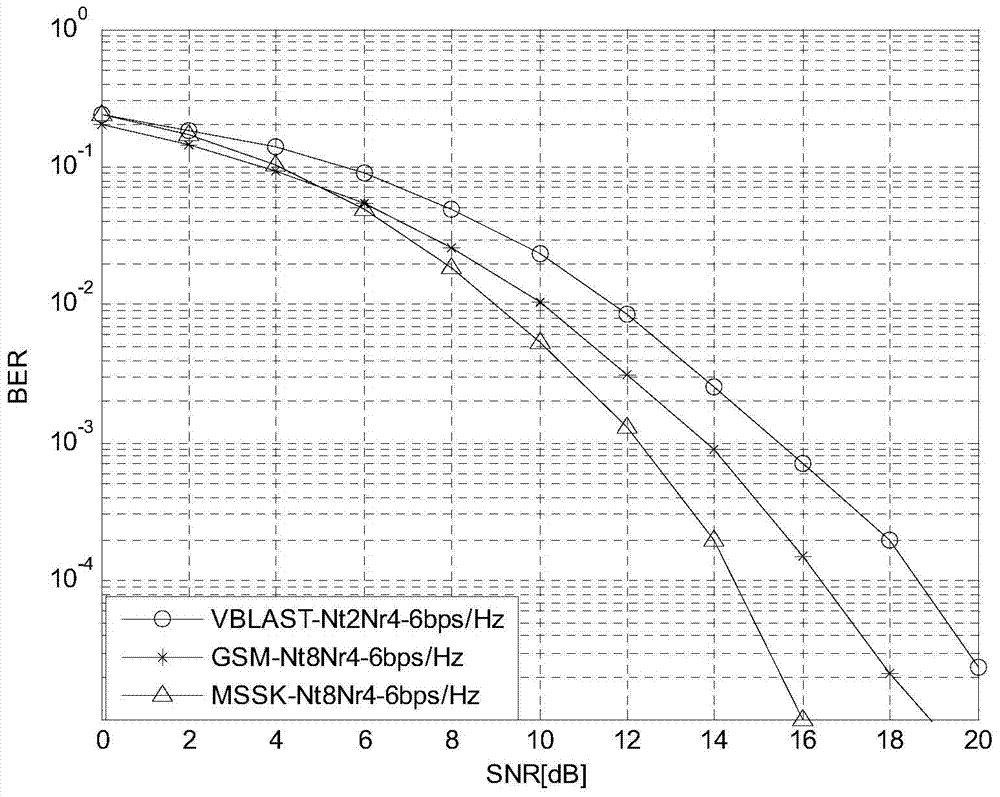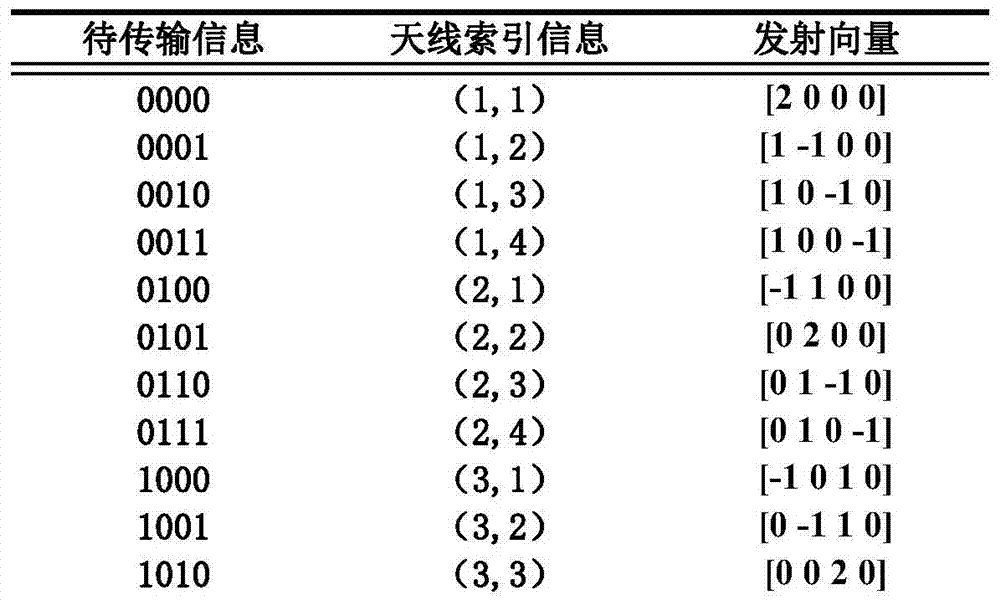Multi-stream space shift keying modulation and demodulation method in a multi-input multi-output system
A modulation method and multi-output technology, applied in transmission systems, radio transmission systems, electrical components, etc., can solve problems such as large codebooks, inability to meet the needs of higher frequency efficiency, waste of resources at the sending end, etc., to improve spectrum efficiency Effect
- Summary
- Abstract
- Description
- Claims
- Application Information
AI Technical Summary
Problems solved by technology
Method used
Image
Examples
Embodiment 1
[0053] Number of transmit antennas N t =4, the number of receiving antennas N r =4, the system transmits K=2 streams of data in total, and each stream of data contains b=2 bits of data, that is, the system sends data in groups of Kb=4 bits. Assume that sending 4bit data is 1101.
[0054] First, traditional SSK modulation is performed on the 2 channels of data to obtain the original antenna mapping number. The SSK modulation rule is to convert binary to decimal and add 1 to obtain n 1 = 4, n 2 =2. For the system of K=2, this embodiment uses BPSK symbols to distinguish different 2-stream data and satisfies the criterion that the modulation symbols of the odd-numbered stream and the even-numbered stream add up to 0, and the modulation symbols of the two streams satisfying the above rules are respectively x 1 =+1,x 2 =-1.
[0055] According to the antenna number determined by the above SSK modulation and the transmission symbol of each stream, the first transmission vector x...
Embodiment 2
[0062] N t = 4, N r =4, K=2, b=2, 1010 for sending 4bit data.
[0063] First, traditional SSK modulation is performed on the two channels of data to obtain the original antenna mapping number n 1 = 3, n 2 = 3, then choose x 1 =+1,x 2 =-1 as the modulation symbols of the two streams of data respectively.
[0064] According to the antenna number determined by SSK modulation and the transmission symbol of each stream, the first transmission vector x is obtained 1 =[0,0,1,0] T , the second emission vector x 2 =[0,0,-1,0] T .
[0065] The emission vectors generated by the two streams of data are sequentially superimposed. First, initialize the total send vector x=x 1 , and then the second emission vector x 2 superimposed on x, since the emission vector x 2 is the transmission vector generated by the even stream data. Before superimposing, compare whether the second stream data is the same as the first stream data. Consider the antenna index numbers of the first stream da...
Embodiment 3
[0068] N t =8,N r =4, K=4, b=3, the 12bit data to be sent is 111011100100.
[0069] First, traditional SSK modulation is performed on the 4 channels of data to obtain the original antenna mapping number. The SSK modulation rule is to convert binary to decimal and add 1 to obtain n 1 = 8, n 2 = 4, n 3 = 5, n 4 =5. For the system of K=4, this embodiment uses QPSK symbols to distinguish different 4-stream data and satisfies the criterion that the modulation symbols of adjacent odd-numbered streams and even-numbered streams add to 0, and two-stream modulation symbols satisfying the above rules can be obtained x respectively 1 =+1,x 2 =-1, x 3 = i, x 4 =-i.
[0070] According to the antenna number determined by the above SSK modulation and the transmission symbol of each stream, the first transmission vector x is obtained 1 =[0,0,0,0,0,0,0,1] T , the second emission vector x 2 =[0,0,0,-1,0,0,0,0] T , the third launch vector x 3 =[0,0,0,0,i,0,0,0] T , the fourth emis...
PUM
 Login to View More
Login to View More Abstract
Description
Claims
Application Information
 Login to View More
Login to View More - R&D
- Intellectual Property
- Life Sciences
- Materials
- Tech Scout
- Unparalleled Data Quality
- Higher Quality Content
- 60% Fewer Hallucinations
Browse by: Latest US Patents, China's latest patents, Technical Efficacy Thesaurus, Application Domain, Technology Topic, Popular Technical Reports.
© 2025 PatSnap. All rights reserved.Legal|Privacy policy|Modern Slavery Act Transparency Statement|Sitemap|About US| Contact US: help@patsnap.com



